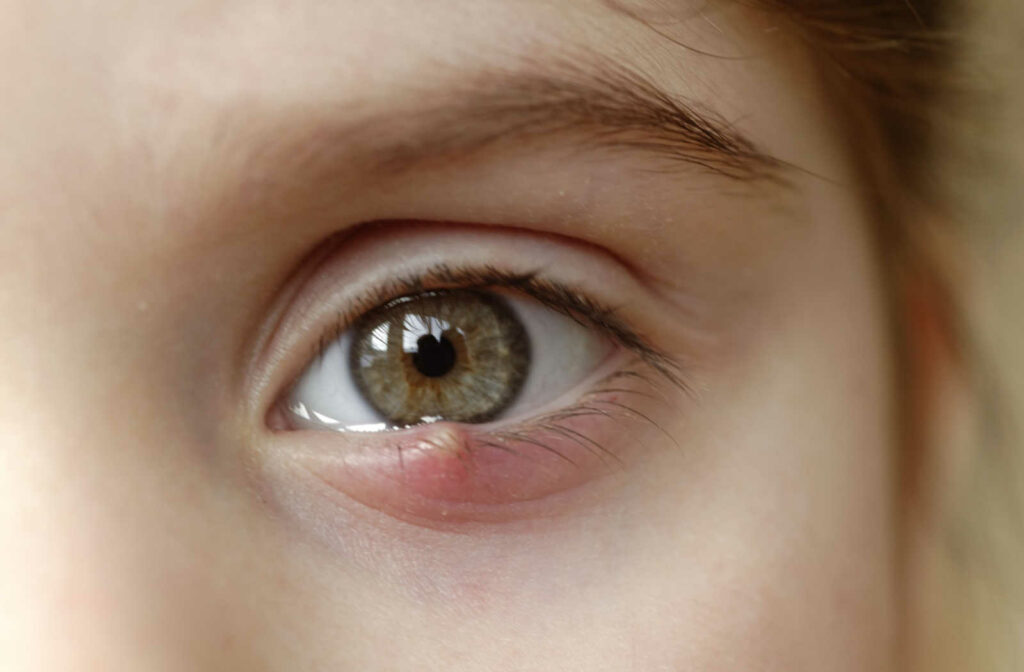Do Dry Eyes Cause Styes?
Dealing with uncomfortable dry eye symptoms is annoying enough, let alone wondering if the condition is causing other problems. For example, because they can happen at the same time you’re experiencing dry eyes, some people may wonder if styes are caused by dry eye disease.
The short answer is no, they aren’t. But it’s important to note that many risk factors that lead to dry eye disease can also lead to an eye stye. So, depending on why you’re prone to get dry eyes, you may be prone to getting a stye as well.
This article reviews each eye condition and gives an overview. Then it dives into their similarities for causes and risk factors with a few tips for treating the conditions at home.
What Is Dry Eye?
Dry eye disease or syndrome is a chronic condition where the eye does not produce enough tears, produces inadequate tears that evaporate prematurely, or a combination of both. It’s often referred to as simply “dry eye.”
Causes of Dry Eye
As mentioned above, there are two main subtypes of dry eye: aqueous deficiency and evaporative. They are characterized by a lack of tears or tears that evaporate too quickly, typically from insufficient oil in the tear film. And each of them typically has different causes, with some overlap
Causes of aqueous deficiency include:
- Aging
- Various medical conditions, such as several autoimmune conditions, thyroid disorders, Vitamin A deficiency, eye allergies, and Sjogren’s syndrome
- Desensitivity of the corneal nerve: Common causes of this include contact lens use, laser eye surgery (typically temporary cause of dry eye), or nerve damage
- Medications, over-the-counter and prescription: Allergy medicines, hormone replacement therapy, birth control, and other medicines could all lead to a lack of tears
Causes of evaporative dry eye include:
- Meibomian gland dysfunction (MGD)
- Not blinking enough
- Eye allergies
- Preservatives in eye drops
- Environmental factors like wind, smoke, or dry air
- Vitamin A deficiency
What are Styes?
You’ll typically know an eye stye when you see it because they usually look like a painful, red bump near the eyelid’s edge. Most times, a stye develops on the outside of the eyelid, but it can occasionally start on the inside.
A stye is commonly caused by a bacterial infection in the eyelid’s oil glands. Although a stye can cause significant discomfort, they don’t usually cause any lasting problems and typically go away on its own within a couple of days.

Connection Between Dry Eye and Styes
We can see that dry eye doesn’t cause styes, and they don’t have a ton of shared causes. So, one might wonder how they are connected and why they may appear together. The bacteria as a cause for styes is the clue!
Bacteria doesn’t necessarily cause dry eyes, but it’s connected.
If there is a buildup of contaminants on the eyelids, this can lead to MGD. This is why eyelid cleaning and meibomian gland expression are common treatments for dry eye.
The same contaminants that sometimes lead to dry eyes could also lead to an uncomfortable infection that causes a stye. So, there may be times when someone experiences both of these conditions simultaneously.
Taking Care of Your Eyes
One of the key takeaways regarding the connection between dry eye and styes is the importance of good hygiene for our ocular health. Things like minimizing face and eye touching are a good idea. Additionally, ensuring hands are thoroughly washed beforehand is an essential part of this.
Let’s look at a few potential treatments you can try at home for each condition.
Treating Dry Eye
Treatments include:
- Thorough eyelid cleaning
- Warm compress
- Lubricating, preservative-free eye drops
- Extra fatty acids in your diet
Typically dry eye is simply uncomfortable and doesn’t lead to serious complications. But if severe enough and left untreated, it could lead to an increased chance of infection or an abrasion injury to the eye’s surface.
Treating Styes
In many cases, a stye won’t need treatment because they typically go away on their own within a couple of days. But a warm compress can help relieve some discomfort and help speed up the healing.
If the pain worsens or doesn’t resolve in a few days, you should call your eye doctor. After explaining your symptoms, they may suggest you come in for an emergency appointment.
Take Your Eye Comfort Seriously
Many eye-related conditions or diseases have the potential for serious discomfort. Fortunately, many of these same things are treatable. If you’re experiencing any eye discomfort, give us a shout at eyeDOCS Ottawa. Our helpful staff can answer your questions and get you in to see one of our optometrists.




